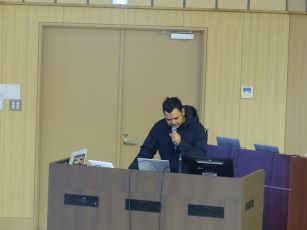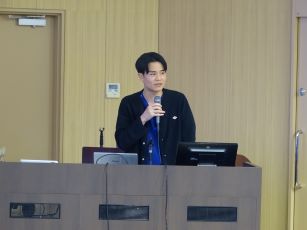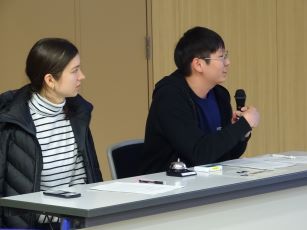- Home
- Student Activity
- Student Monthly Progress #10
The 10th Student Monthly Progress presentation was held on March 22nd, 2024.
【Presenter】
1. ISLAM MD Mominul:Laboratory of Physiology
<Identification of Cibacron Blue 3G-A as an inhibitor of Otopetrin 1 (OTOP1), a proton-selective ion channel>
2. SHIOHARA Nozomi:Laboratory of Veterinary Internal Medicine
<Feasibility of Shear Wave Elastography for the assessment of inflammation and fibrosis in dogs with hepatic disease>
3. KODUA Emmanuel:Laboratory of Genetic Medicine
<Confirmation studies on whether renal hemorrhage in Korean Hemorrhagic Fever Virus clone 5 leads to renal damage>
【Chair】
THAMMAHAKIN Passawat:Laboratory of Public Health
KOVBA Anastasiia:Laboratory of Wildlife Biology and Medicine
❖Chairperson's Report❖
Three students introduced their research during the Student Monthly Progress Meeting.
ISLAM MD Mominul’s research aims to identify a novel inhibitor of otopetrin1 (OTOP1) by screening a chemical library, LOPAC1280, using a heterologous expression system and whole-cell patch-clamp recording. The OTOP1 is a proton channel that receives the extracellular acidity in sour taste receptor cells and induces otoconia formation in the vestibular system. Recently, only zinc ion (Zn2+) was used to inhibit OTOP1 and there were no other inhibitors have been found. He screened a chemical library by measuring proton currents of heterologously-expressed mouse OTOP1 using the whole-cell patch clamp technique and found cibacron blue 3G-A potently inhibited OTOP1 currents. These findings highlight Cibacron blue 3G-A as a novel inhibitor of OTOP1, which can be useful for OTOP1 activity studies.
In his research, SHIOHARA Nozomi investigates the usefulness of shear wave elastography (SWE) to evaluate inflammation and fibrosis in dogs with hepatic disease. SWE is an ultrasound technique, which measures shear wave speed (SWS), an index of viscoelasticity, and dispersion slope (DS), an index of viscosity. Fibrosis increases elasticity in liver tissue, while congestion or inflammation increases viscosity. SWE is widely used for human liver diseases diagnosis, but its use has not yet been tested in animals. By testing SWE in dogs with inflammation and fibrosis confirmed by biopsy, he shows that elevated SWS reflects fibrosis and elevated DS reflects inflammation, which is similar to results obtained in humans. In conclusion, SWE can be useful in assessing inflammation and fibrosis for dogs with hepatic disease.
Finally, KODUA Emmanuel introduced his research on the association between Korean hemorrhagic fever virus clone-5 (KHF5) and renal damage. The Hantaan virus is the causative agent of hemorrhagic fever with renal syndrome (HFRS). The Hantaan virus strain, KHF5, causes weight loss and renal hemorrhage in laboratory mice. He aims to elucidate the extent of renal impairment associated with KHF5 infections. He performs mouse experiments with a special cage, a metabolic cage, for urine collection. The serial urine following infection was collected and examined total protein expression in the kidney by immunoblotting and immunohistochemistry. This preliminary data collected and analyzed showed the classical periods of disease onset by the amount of urine produced and increased proteinuria in infected mice.
This meeting provided valuable insights into research conducted by fellow PhD students in physiology, internal medicine, and virology. Through this activity, students are expected to get familiar with research activities beyond their interests and cultivate a collaborative research mind which is critical as a zoonosis control expert and a chemical hazard control expert.






